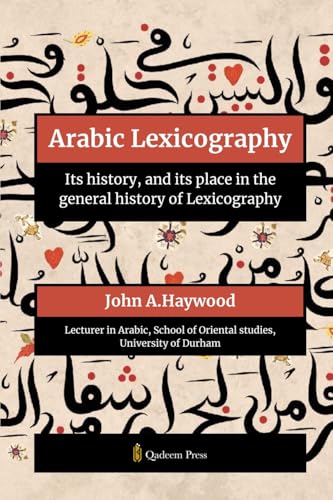Arabic Lexicography – Its history, and its place in the general history of Lexicography
John A. Haywood
Paperback, 154 Pages, Black & White
6 x 9 Inches
Qadeem Press
Embark on a captivating journey through the fascinating evolution of Arabic lexicography with John A. Haywood’s meticulously researched masterpiece, “Arabic Lexicography: Its History and Its Place in the General History of Lexicography.” In this engaging exploration, Haywood traces the development of Arabic dictionaries from their origins to their profound influence on modern European lexicography.
Haywood’s dedication to his subject is palpable as he expertly navigates through centuries of linguistic history, shedding light on key figures such as Al-Khalil ibn Ahmad and his pioneering work, “Kitab al-‘Ain.” This cornerstone of Arabic lexicography serves as a springboard for understanding the intricate evolution of dictionary arrangements, from early anagrammatic structures to the sophisticated rhyme-based systems found in works like the “Lisän al-Arab” and the enduring “Qamüs.”
Through meticulous research and scholarly rigor, Haywood not only chronicles the historical progression of Arabic lexicography but also underscores its enduring relevance in contemporary linguistic studies. From classical Arabic dictionaries to modern arrangements and vocabularies, Haywood’s work offers a comprehensive examination of one of the most significant traditions in the study of language.
Whether you’re a seasoned linguist, a passionate historian, or simply a language enthusiast, “Arabic Lexicography” promises to captivate and inspire. With its rich tapestry of linguistic heritage, the book invites readers to delve deep into the cultural and intellectual contributions of Arabic lexicography, shaping our understanding of language across diverse cultures and continents.
Prepare to be enthralled by the profound influence of Arabic lexicography on the development of modern European lexicography. Haywood’s masterful narrative not only illuminates the historical connections between Arabic and European traditions but also underscores the ongoing dialogue and exchange of linguistic knowledge between different cultures and civilizations.
In “Arabic Lexicography,” Haywood invites readers on a transformative journey through centuries of linguistic evolution. From ancient roots to contemporary relevance, this book is a testament to the enduring legacy of Arabic lexicography and its profound impact on our understanding of language and culture.
Table of Contents:
I: Lexicography before the Arabs
II: The Origins of Arabic Lexicography
III: Al-Khalil ibn Ahmad
IV: “Kitab al-‘Ain”
V: Further dictionaries in the Anagrammatic Arrangement of al-Khalil
VI: The Rhyme Arrangement: the “Sahah” of al- Jauhari
VII: Later Dictionaries in the Rhyme Arrangement: the “Lisän al-Arab” and the “Qamüs”
VIII: The Modern Dictionary Arrangement
IX: Vocabularies
X: The Influence of Arabic Lexicography
The Development of Modern European Lexicography





